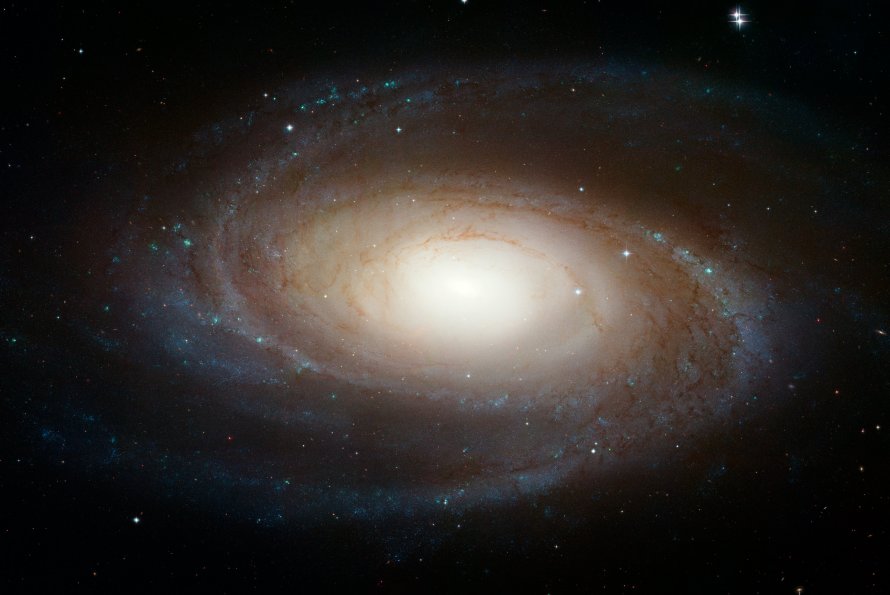M81 (NGC 3031) - Bode's Galaxy
Messier 81 (NGC 3031), also known as the Bode's Galaxy, is a spiral galaxy located in the constellation Ursa Major in the M81 Group of galaxies. M81 is 11800000 light years away from Earth.
M81 is best viewed during early spring, is magnitude 6.9, and can be viewed with binoculars. M81 is 27' x 14' in apparent size. For reference, the full moon is 30'.
Observing difficulty: Easy
- Name:
- Bode's Galaxy
- Type:
- spiral galaxy
- Constellation:
- Ursa Major
- NGC or IC:
- NGC 3031
- Magnitude:
- 6.9
- Viewing:
- binoculars
- Size:
- 27' x 14'
- Distance (light years):
- 11800000 LY
- RA:
- 9h 55.6m
- Dec:
- 69 4'
- Season:
- early spring
- Galaxy group:
- M81 Group
- Messier Marathon #:
- 34
* The naked eye can see up to magnitude ~7-8 objects under ideal dark sky conditions.
An In-depth Study of Bode's Galaxy
One of the most studied and well-known galaxies in the night sky, Messier 81, also known as Bode's Galaxy, is a spiral galaxy situated in the Ursa Major constellation. First discovered by the German astronomer Johann Elert Bode in 1774, M81 is a captivating astronomical object that offers a wealth of scientific insights.
Characteristics of M81
M81 is a grand design spiral galaxy, meaning its spiral arms are well defined and symmetrical, extending out from the galaxy's nucleus in a clear and ordered pattern. Its elegant form, characterized by bright arms and a dense, luminous core, is a classic example of a spiral galaxy. Moreover, M81 is the largest galaxy in the M81 Group, a group of 34 galaxies located in the Ursa Major constellation, which also includes the famous M82, or the Cigar Galaxy.
From a scientific perspective, M81 is particularly intriguing because it hosts an active galactic nucleus, suggesting the presence of a supermassive black hole in its core. The mass of this black hole is estimated to be about 70 million times the mass of the Sun. Observations of this galaxy have greatly enhanced our understanding of black holes and the dynamics of spiral galaxies.
Magnitude and Size
With an apparent magnitude of 6.9, Messier 81 is not visible to the naked eye but is readily accessible to small telescopes and binoculars. This galaxy spans an area of 26.9 x 14.1 arcminutes in the sky, roughly translating to a linear diameter of 90,000 light-years, making it about 90 percent the size of the Milky Way.
Finding and Viewing M81
Locating M81 can be relatively straightforward, especially for observers in the Northern Hemisphere. This galaxy resides in the constellation of Ursa Major, close to the Big Dipper asterism. Specifically, drawing an imaginary line from Phecda to Dubhe, two stars of the Big Dipper's bowl, and extending it a similar distance further, will lead to the location of M81. Given its close proximity to M82, another bright galaxy, both objects can often be viewed in the same field of view with binoculars or a small telescope, offering a delightful celestial spectacle.
A small telescope will reveal M81 as a faint, elongated smudge of light with a brighter center. With larger telescopes under dark skies, some details of the spiral arms can be glimpsed. Astrophotographers, using long exposure times and image processing techniques, can capture M81's spiral structure and its subtle details with impressive clarity.
The accessibility and striking beauty of M81, along with its scientific relevance, make it a prime target for both amateur and professional astronomers. As we peer into the heart of this galaxy, we are offered a unique glimpse into the vast, mysterious cosmos, reinforcing our passion for exploring the universe and unveiling its many secrets.



